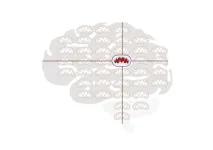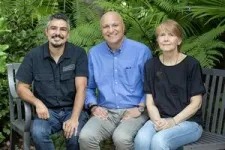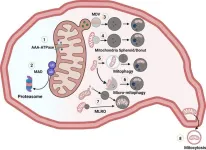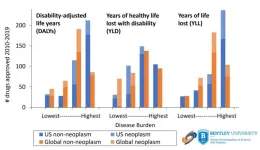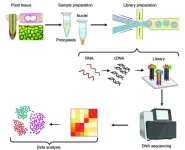A team of Medical University of South Carolina researchers, led by Onder Albayram, Ph.D., reports in PNAS Nexus that they have discovered a novel protective response by which the brain naturally repairs itself after traumatic brain injury. Findings could lead to drug treatments that improve the brain’s ability to recover after concussions and prevent long-term brain disease.
“Brain recovery mechanisms are very, very powerful,” said Albayram. “We don’t always have to develop new treatment approaches. We can also just give the brain a chance to heal itself properly.”
Repetitive mild traumatic brain injury, or repeated concussions, are common, especially among athletes in high-contact sports or military personnel involved in combat. The long-term health consequences of a concussion range from mild to severe.
For some people, repeated blows to the head can trigger a domino effect of secondary brain disease. They can develop chronic traumatic encephalopathy, a progressive type of dementia with no known cure. In fact, brain injuries are the No. 1 environmental risk factor for neurodegenerative brain diseases, such as Alzheimer’s disease or other dementias, said Albayram.
“This is the $1 million question: ‘Why do some athletes live healthily into retirement, while others develop brain disease?’” asked Albayram. “We believe it is because the recovery mechanisms in the brain may not be functioning well for some people.”
After concussions, damaged brain tissue builds up in the part of the cellular compartment called the mitochondria, he explained. This accumulation of damaged tissue prevents the mitochondria from functioning well, leading the brain cell to die. To repair itself, the brain can vacuum up the damaged mitochondria in a process called mitophagy.
The protein p17 has been shown to play a small but unique role in mitophagy in other parts of the body. Triggered by stress, the p17 protein transports important enzymes to the cell, flags the damaged tissue and initiates the healing process of mitophagy. Albayram and his team wanted to find out if p17 played a similar protective function in the brain.
This is the first study to show that the protein p17 does indeed play a crucial role in protecting the brain after repeated concussions. When researchers removed p17 in the brain cells of mice, they developed secondary disease after injury.
Albayram and his team then tested a therapeutic approach for secondary brain disease. They created an analog drug that artificially triggered the restorative process of mitophagy in mice. Administering this drug to mice healed most of their brain disease.
To test their findings clinically, Albayram and his team examined postmortem human brains with and without long-term brain disease from concussions. Albayram was surprised to find that protein p17 levels were notably lower in the brains with disease. This outcome confirms what the team discovered in preclinical models – that protein p17 plays a small but mighty role in how the brain protects itself from disease.
Protein p17 could be a target for future treatments that protect the brain after concussions and prevent long-term health consequences.
Because researchers were able to trigger this recovery process in a preclinical model, a future goal is to develop similar drug treatments for humans. Yet, beyond just traumatic brain injury, these findings could inform how we treat brain disease broadly.
Albayram encourages brain scientists not to reinvent the wheel. Just as vaccines boost the natural protective properties of the body to fight viruses, we can improve the recovery properties of the brain to fight disease.
“We can help the brain to cure itself,” said Albayram.
# # #
The content in the underlying article is solely the responsibility of the authors and does not necessarily represent the official views of the National Institutes of Health.
About the Medical University of South Carolina
Founded in 1824 in Charleston, MUSC is the state’s only comprehensive academic health system, with a unique mission to preserve and optimize human life in South Carolina through education, research and patient care. Each year, MUSC educates more than 3,200 students in six colleges – Dental Medicine, Graduate Studies, Health Professions, Medicine, Nursing and Pharmacy – and trains more than 900 residents and fellows in its health system. MUSC brought in more than $300 million in research funds in fiscal year 2023, leading the state overall in research funding. MUSC also leads the state in federal and National Institutes of Health funding. For information on academic programs, visit musc.edu.
As the health care system of the Medical University of South Carolina, MUSC Health is dedicated to delivering the highest-quality and safest patient care while educating and training generations of outstanding health care providers and leaders to serve the people of South Carolina and beyond. Patient care is provided at 16 hospitals (includes owned or governing interest), with approximately 2,700 beds and four additional hospital locations in development, more than 350 telehealth sites and nearly 750 care locations situated in all regions of South Carolina. In 2023, for the ninth consecutive year, U.S. News & World Report named MUSC Health University Medical Center in Charleston the No. 1 hospital in South Carolina. To learn more about clinical patient services, visit muschealth.org.
MUSC has a total enterprise annual operating budget of $5.9 billion. The nearly 26,000 MUSC family members include world-class faculty, physicians, specialty providers, scientists, students, affiliates and care team members who deliver groundbreaking education, research, and patient care.
END
Discovery of a natural protective response in the brain could lead to treatments for concussions
Medical University of South Carolina researchers discover cellular process that naturally protects the brain after injury, informing future treatments for brain disease.
2024-03-12
(Press-News.org)
ELSE PRESS RELEASES FROM THIS DATE:
Climate polices to reduce motor vehicle emissions can improve children’s health, save money
2024-03-12
A new study finds that policies to reduce carbon dioxide (CO2) emissions from motor vehicles combined with investments in electric vehicles and public transportation would reduce air pollution and bring large benefits to children’s health. They would also save money.
The findings by researchers at Columbia University Mailman School of Public Health with collaborators at the University of California, Los Angeles, the University of North Carolina at Chapel Hill, and the Boston University School of Public Health appear in the journal Environmental Research ...
Research finds a college degree remains a sound investment despite rising tuition
2024-03-12
A new analysis of 5.8 million Americans finds that earning a college degree is still a sound investment, although the rate of economic return varies across college majors and student demographics. The findings come as skepticism continues to grow over the value of a degree in the face of rising college costs, a decline in college enrollment, and a transforming economy.
The study was published today in American Educational Research Journal, a peer-reviewed journal of the American Educational Research Association. It was conducted by Liang Zhang from New York University, Xiangmin Liu from Rutgers University, and Yitong Hu from New York University.
The study estimated ...
Understanding chronic liver disease through the powerhouse of the cells
2024-03-12
Scientists have identified a new organelle in liver cells called the mitochondria-lysosome-related organelle (MLRO). This discovery could improve our understanding of chronic liver diseases like alcohol-associated liver disease (ALD) and metabolic dysfunction-associated fatty liver disease (MAFLD).
Mitochondria are essential components of cells, often called the "powerhouses" because they generate energy. They also play a crucial role in metabolism, calcium signalling, and cell survival. When mitochondria malfunction, it's linked to various liver diseases.
Cells have intricate mechanisms to maintain healthy mitochondria. One way is to ...
Outstanding achievements of UNIST students at the 30th Samsung Humantech Paper Award ceremony!
2024-03-12
Four exceptional UNIST students were honored for their outstanding academic and research achievements at the prestigious 30th Annual Samsung Humantech Paper Award ceremony.
Among the many eminent individuals, JungSoo Lee (Advisor: Professor Han Gi Chae) from the Department of Materials Science and Engineering notched the highest score and won the Gold Prize within the category of Energy & Environment. His groundbreaking research on enhancing the efficiency of thermoelectric power generation through the development of a new power generation device structure technology earned him this accolade. By focusing on optimizing the structure ...
Increasing disability employment could boost national economy by billions
2024-03-12
-- There is a widening employment gap between people with and without disability --
-- In 2022, only 53.1 per cent of people with work-limiting disability were employed, compared to 81.8 per cent of people without disability --
-- People with disability are 25-30 percentage points less likely to be employed --
-- Over a quarter of people with disability cite transport as a barrier to finding work --
A new report by the Bankwest Curtin Economics Centre at Curtin University reveals that there has been no improvement in employment rates for people with disability ...
Novel risk score for cardiovascular complications after bone marrow transplant
2024-03-12
For thousands of Americans each year, a bone marrow transplant has the potential to cure diseases such as leukemias, lymphomas and immune deficiency disorders. While lifesaving, bone marrow transplants are taxing procedures that can affect various organs, including the cardiovascular system.
With advances in medical science and improvement in protocols, more bone marrow transplants, also known as hematopoietic stem cell transplantation, are being offered to older patients, a population at greater risk of cardiovascular disease.
Researchers led by ...
US drug approvals 2010-2019 align with US, but not global, burden of disease; expedited approval programs may make the gap worse
2024-03-12
BENTLEY UNIVERSITY
Drug approvals in the United States between 2010-2019 were aligned with the US, but not global, burden of disease and the increasing number of expedited drug approvals could make the gap worse according to a study in the BMJ Open. The study also demonstrates that drugs indicated for conditions with the greatest burden of disease were less likely to be approved through the FDA’s expedited approval programs that reduce the timeline and cost of drug development, thus making it relatively more expensive to develop these products. US markets and FDA approval play an important role in shaping the product portfolios of global pharmaceutical companies; as such, expedited ...
Rising incidence of Legionnaires’ disease due to cleaner air
2024-03-12
A study links a rise in a serious bacterial illness to an unexpected factor: a decline in air pollution. Legionnaires’ disease is a respiratory illness with a fatality rate of 10–25% that is caused by inhaled Legionella bacteria. The bacteria live in water and outbreaks have been linked to water sources such as cooling towers, which cool indoor spaces by dissipating heat into the atmosphere in the form of water droplets and vapor. Other sources include improperly maintained public fountains, hot tubs, ice machines, home humidifiers, and showers. A global rise in Legionnaires’ disease since the year 2000 has puzzled ...
You didn’t see it coming: the spontaneous nature of turbulence
2024-03-12
We experience turbulence every day: a gust of wind, water gushing down a river or mid-flight bumps on an airplane.
Although it may be easy to understand what causes some kinds of turbulence — a felled tree in a river or a bear splashing around for salmon — there is now evidence that a very small disturbance at the start can have dramatic effects later. Instead of a tree, think of a twig — or even the swerving motion of a molecule.
University of California San Diego Chancellor’s Distinguished Professor of Physics Nigel Goldenfeld, along with his former student Dmytro Bandak, and Professors Alexei ...
Advancing plant biology with breakthroughs in single-cell RNA sequencing
2024-03-12
Recent breakthroughs in single-cell RNA sequencing (scRNA), such as the recently developed “RevGel-seq” method, has revolutionized plant cell analysis. This technique, independent of special instruments, streamlines processes and resolves protoplast isolation challenges. Now, a multinational team of researchers review this and other such recent advances in plant scRNA sequencing with the intention of providing guidance for facilitating the appropriate selection of scRNA methods for different plant samples.
In the world of plant biology, understanding ...
LAST 30 PRESS RELEASES:
Making lighter work of calculating fluid and heat flow
Normalizing blood sugar can halve heart attack risk
Lowering blood sugar cuts heart attack risk in people with prediabetes
Study links genetic variants to risk of blinding eye disease in premature infants
Non-opioid ‘pain sponge’ therapy halts cartilage degeneration and relieves chronic pain
AI can pick up cultural values by mimicking how kids learn
China’s ecological redlines offer fast track to 30 x 30 global conservation goal
Invisible indoor threats: emerging household contaminants and their growing risks to human health
Adding antibody treatment to chemo boosts outcomes for children with rare cancer
Germline pathogenic variants among women without a history of breast cancer
Tanning beds triple melanoma risk, potentially causing broad DNA damage
Unique bond identified as key to viral infection speed
Indoor tanning makes youthful skin much older on a genetic level
Mouse model sheds new light on the causes and potential solutions to human GI problems linked to muscular dystrophy
The Journal of Nuclear Medicine ahead-of-print tip sheet: December 12, 2025
Smarter tools for peering into the microscopic world
Applications open for funding to conduct research in the Kinsey Institute archives
Global measure underestimates the severity of food insecurity
Child survivors of critical illness are missing out on timely follow up care
Risk-based vs annual breast cancer screening / the WISDOM randomized clinical trial
University of Toronto launches Electric Vehicle Innovation Ontario to accelerate advanced EV technologies and build Canada’s innovation advantage
Early relapse predicts poor outcomes in aggressive blood cancer
American College of Lifestyle Medicine applauds two CMS models aligned with lifestyle medicine practice and reimbursement
Clinical trial finds cannabis use not a barrier to quitting nicotine vaping
Supplemental nutrition assistance program policies and food insecurity
Switching immune cells to “night mode” could limit damage after a heart attack, study suggests
URI-based Global RIghts Project report spotlights continued troubling trends in worldwide inhumane treatment
Neutrophils are less aggressive at night, explaining why nighttime heart attacks cause less damage than daytime events
Menopausal hormone therapy may not pose breast cancer risk for women with BRCA mutations
Mobile health tool may improve quality of life for adolescent and young adult breast cancer survivors
[Press-News.org] Discovery of a natural protective response in the brain could lead to treatments for concussionsMedical University of South Carolina researchers discover cellular process that naturally protects the brain after injury, informing future treatments for brain disease.
